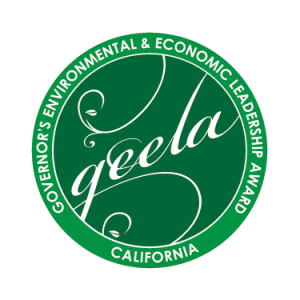Agriculture Well-represented among GEELA Awards
CDFA Secretary Karen Ross joined colleagues from across state government this week to honor recipients of the annual Governor’s Environmental and Economic Leadership Awards or GEELA Awards.
The GEELA program is California’s highest environmental honor – recognizing individuals, organizations, and businesses that have demonstrated exceptional leadership and made notable, voluntary contributions in conserving California’s precious resources; protecting and enhancing our environment; building public-private partnerships; and strengthening the state’s economy.
Secretary Ross was pleased to present awards to Parducci Wine Cellars, for its efforts to conserve and reclaim water; to the Lodi Winegrape Commission, for its rules for sustainable winegrowing; and the California Sustainable Winegrowing Alliance, for the development of metrics for water, energy, and nitrogen use, as well as greenhouse gas emissions.
Parducci Wine Cellars, over the course of 14 years, has come up with unique and innovative ways to reduce, reuse and recycle water at their winery. By using the surrounding landscape and natural ecosystems, Parducci has transformed a polluted pond into a bird sanctuary and created other recreational and habitat uses from its wastewater facility. In addition, the winery now recycles and cleans 100 percent of its wastewater and reuses it for irrigation, resulting in a 1.5 million gallon per year decrease in water usage even as production doubled. Parducci’s Water Reclamation System is proof that ecosystems can be valuable tools in creating efficient, cost-effective methods for water conservation that have tangible long-term environmental and economic benefits.
In 2005, the Lodi Winegrape Commission started California’s original sustainable winegrowing certification program. For their efforts, they were awarded a GEELA in 2006. Since their first year the program has expanded and evolved, and has established a reputation as a model certification program. The program grew from over 1,500 certified acres in 2006 to nearly 27,000 acres in 2013 while continuing to promote practices that enhance biodiversity, water and air quality, and soil health. Growth in the certification program allows for growers throughout the state to recognize the program’s value as a tool for implementing and codifying their practices that meet the triple bottom line of environmentally friendly practices, socially responsible business management and economic viability for maintaining vineyards for future generations.
The California Sustainable Winegrowing Alliance (CSWA) is a statewide sustainable winegrowing program introduced in 2002. CSWA was a recipient of a GEELA in 2004, and, after a major update to their program in 2006, they were also awarded a GEELA in 2010. They continued their trend of innovation after another update to their program in 2012, which includes online performance metrics for water, energy, nitrogen and greenhouse gas emissions, and a winery water guide for small wineries, in addition to new workshops and online tools focused on the results of a carbon footprint study on California wine. CSWA’s program has helped growers and vintners adopt sustainable practices that have improved efficiency and quality and conserved natural resources, reduced risks, and in some cases, reduced costs.
is administered by the California Environmental Protection Agency, in partnership with the Natural Resources Agency; the Department of Food and Agriculture; the State Transportation Agency; the Business, Consumer Services, and Housing Agency; the Labor and Workforce Development Agency; and the Health and Human Services Agency.










